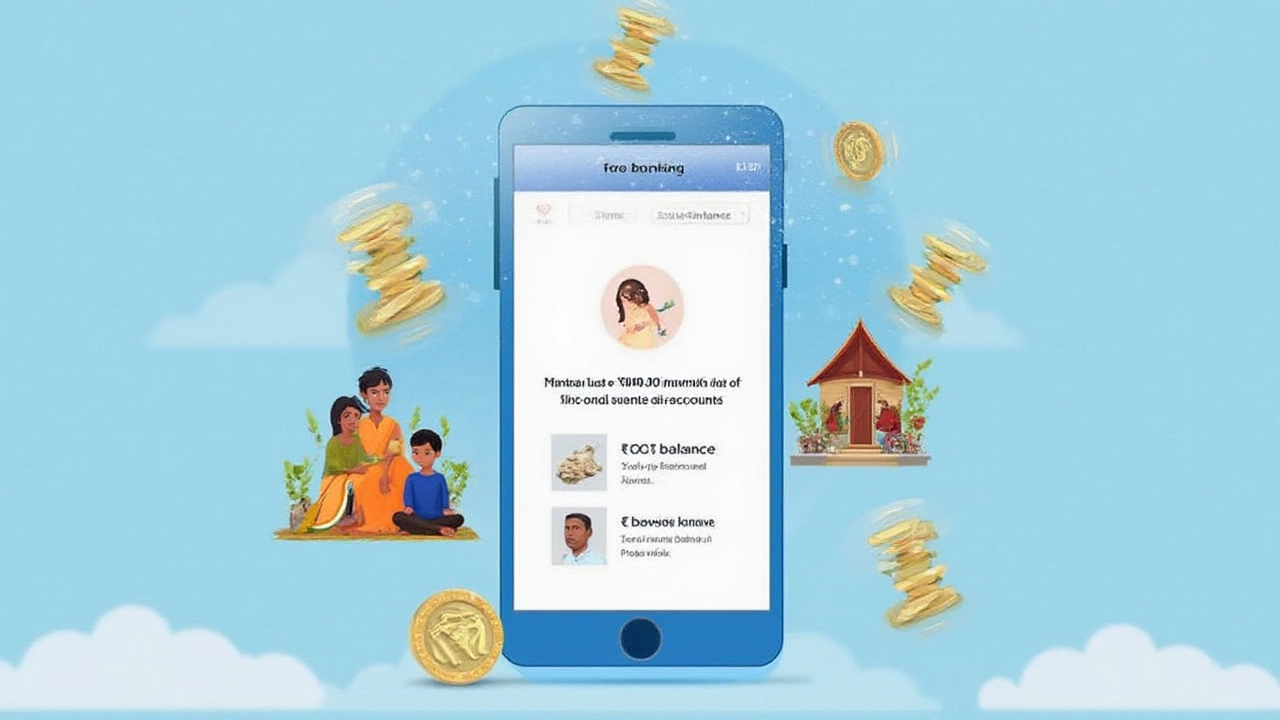Picture this: your bank quietly nibbles away at your funds with penalty charges, just because you missed that sneaky minimum balance rule. It’s not just annoying—it’s expensive. So, finding a bank that lets you keep your savings account running with only ₹1,000 as a minimum balance? Now, that’s a lifesaver. But here’s the catch: Which banks in India actually offer this, and does it really make sense to choose them over zero-balance accounts? Let’s pull apart the policies, hidden details, and practical tips to help you decide where your money feels safest—and works the hardest.
Banks Offering Savings Accounts with ₹1,000 Minimum Balance
If you ask around—at tea stalls, on long train rides, or even in WhatsApp groups—one question that pops up a lot is: “Which bank lets me keep just ₹1,000 as the minimum?” Good question, and it’s more common than you might think, especially for accounts tailored to ordinary folks rather than the big fish. Most of the public sector banks are your best bet if you’re looking for that sweet spot of affordability, trust, and reasonable digital services. Let’s break down some names.
Indian Bank probably sits right at the top when people mention modest minimum balance needs. Their regular savings account needs you to maintain ₹1,000 in metros and a bit less in semi-urban and rural branches. Punjab National Bank (PNB) is not far behind. The regular PNB Saving Fund (General) expects a ₹1,000 minimum in urban areas, ₹500 in smaller towns, and just ₹250 if you’re out in the countryside. Union Bank and Canara Bank tend to set the ₹1,000 minimum for urban or semi-urban branches, with reduced slabs elsewhere.
Even some private banks play ball here—Just not the ’big wallet’ accounts. For instance, IDFC FIRST Bank, for its regular savings product, keeps the urban minimum quite low and gives a little more leeway in non-metro locations. Then there’s Federal Bank, often seen as the friendlier private choice in South India, also asking for ₹1,000 in select basic accounts. Of course, with public sector banks, you often get government-linked benefits, easy cash deposits and ATMs, and huge reach for branch services.
Here’s a snapshot table showing well-known banks and their minimum balance requirements for regular savings accounts (as of July 2025):
| Bank Name | Minimum Balance (Urban/Semi-Urban) | Minimum Balance (Rural) | Penalty Charge (If Below Minimum) |
|---|---|---|---|
| Indian Bank | ₹1,000 | ₹500 | ₹10-100/month |
| Punjab National Bank | ₹1,000 | ₹500/₹250 | ₹20-150/month |
| Canara Bank | ₹1,000 | ₹500 | ₹10-50/month |
| Union Bank of India | ₹1,000 | ₹500 | ₹10-100/month |
| Federal Bank | ₹1,000 | ₹1,000 | ₹50-100/month |
| IDFC FIRST Bank | ₹1,000 | ₹500 | ₹10-150/month |
One thing to notice—the penalty for not keeping the balance can eat into your money pretty fast. So, if you tend to come close to zero or regularly dip under the minimum, watch out. Banks calculate the minimum average balance monthly, so just topping up at the end won’t always save you. Want a quick hack? Set a reminder to check your balance twice a month on your mobile app or internet banking. It’s barely 30 seconds and can keep those nagging penalty SMSes at bay.
A few more things people get tripped up on: sometimes, branches within the same bank can have slightly different policies. For example, an account opened in New Delhi might have a higher slab than one opened in Trichy or Lucknow. Always confirm at your local branch, or better yet, check the bank’s latest website update.
More banks are also rolling out new digital or basic variants, sometimes with just ₹500 required as balance—especially under government initiatives like PMJDY (Jan Dhan Yojana). But if you’re sticking to mainstream savings accounts with broad ATM access, ₹1,000 is your golden number with these names.

Understanding the Fine Print: How Minimum Balance Rules Affect You
Most people skip the fine print, and let’s be honest—bank paperwork is about as fun as waiting in line at the RTO. But things can change fast if you’re not careful. Minimum balance means two things: one, you’re expected to keep at least the specified amount in your savings account daily, monthly, or on average per month. Two, if you slip, the penalty kicks in, often charged directly to your account without warning.
Penalties can add up. For instance, missing the minimum for two months might cost you between ₹20 to ₹200 in fees, and yes, they’ll tax you on those penalties too. Some banks hit you harder in metro branches, assuming city folk can afford more. There’s a running joke that the only thing punctual about banks is debiting you for non-maintenance!
The calculation can also get confusing. Most banks now calculate Minimum Average Balance (MAB)—total sum of money in your account daily during the month, divided by the number of days. If you have ₹3,000 for ten days, and zero for the next twenty, your average plummets and so does your wallet when penalty time hits. Don’t play the "I’ll deposit at month end" game—it rarely works out unless you time it perfectly.
ATMs linked to your account often remind you about non-maintenance, but many just flash a warning instead of blocking transactions. Digital banking comes to your rescue here: almost all major Indian banks have mobile apps with an ‘Account Balance’ section—use it. Some even show your average balance for the month; that's the real number to check, not just your current available funds.
One smart workaround is setting up a low-risk recurring deposit (RD) sweep. With some banks, you can sweep out all balance above ₹1,000 into a short-term RD. If you ever drop below the threshold, the RD sweeps funds back in, saving you the penalty. This way, your money might even earn a tad more in interest instead of sitting around doing nothing.
Family or joint accounts sometimes merge balances for multiple members. So, if your spouse or parent slips up, it could pull the main account holder down too. Always clarify the account terms before you say yes to a joint account, especially for senior citizen or child accounts.
Bank marketing always talks about ‘free benefits’—think debit cards, passbooks, checkbooks, digital banking—but some are only free if you maintain the minimum balance. Slip under, and you might lose out on those perks, or see stealth charges appear on your next bank statement.
Last bit: don’t ignore old accounts. Many folks have opened accounts for an exam, campus recruitment, or loan disbursement, then forget all about them. Non-maintenance fines build up, and before you know it, you owe more in fees than what’s left in the account. Always close unwanted accounts or at least keep enough balance in them to avoid headaches six months later.

Should You Settle for ₹1,000 Minimum Balance or Go Zero Balance?
If banking was a bazaar, the zero-balance account would be the ‘no haggling’ zone. It looks like a bargain—no minimums, no penalties, simple features. So why don’t more people just jump for it?
Public sector giants like the State Bank of India (SBI), Bank of Baroda, and Central Bank of India have rolled out zero-balance options. Usually, these are ‘Basic Savings Bank Deposit Accounts’ (BSBDA). No penalties, but the trade-off is strict limits—only four ATM transactions a month free, some blocks on checkbooks, and no overdraft facilities. If you only use your account to save, get salary, or receive scholarships, this is perfect. But if you want a bit more flexibility—unlimited ATM swipes, online shopping, larger deposits—the regular banks with 1000 minimum balance keep you in the game.
Zero-balance accounts are also pushed under the Jan Dhan banner—open to anyone above age 10, government insurance linked, and often with accidental coverage. As of July 2025, over 50 crore Jan Dhan accounts exist in India. Yet, a study by RBI showed that nearly 20% of these stay dormant each year, mostly because people need those ‘extras’ that regular savings accounts offer.
Here are a few tips if you’re torn between the two:
- If you don’t mind missing out on premium services—or if most of your transactions are digital and infrequent—pick zero-balance. You won’t lose sleep over fines.
- If you need better ATM coverage, debit cards, or plan to upgrade to a loan or credit card in the future, the regular ₹1,000 minimum balance account is a safer ticket.
- Students and young professionals should look at ‘youth savings’ or ‘salary accounts’—most banks waive the minimum on these accounts for the first one or two years.
- If you keep multiple bank accounts, stagger them—use a zero-balance one for government receipts or subsidies, a ₹1,000 account for daily spending. This way, you avoid piling up penalties everywhere.
- Ask about automatic downgrade: Many banks now let you downgrade an account to zero-balance or basic if you stop using premium features. Save yourself hassle by switching rather than paying fines.
One thing often misunderstood: interest rates. Banks with low or zero minimum requirements aren’t stingy with interest. In fact, the race for digital accounts has led to competitive rates—Federal and IDFC FIRST regularly hover above 3.5% to 6% per annum on savings. No bank will pay you 7% just for moving money around all day but compare offers—you might get more with lower minimums if you check the fine print.
For those who like direct answers: Yes, plenty of Indian banks let you open and keep a savings account with just ₹1,000 as the minimum average monthly balance. Public sector favorites like Indian Bank, PNB, Canara, and Union Bank lead the charge, with a few private banks like Federal and IDFC FIRST following suit. But always stay wary of those penalties, know your usage pattern, and don’t ignore the fine print or the dormant accounts hiding in your name. And, with both digital and public bank options fighting to offer more with less, you’ve got choices—so weigh your own priorities.
